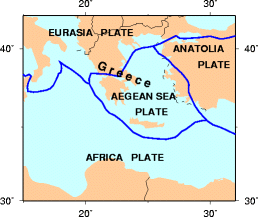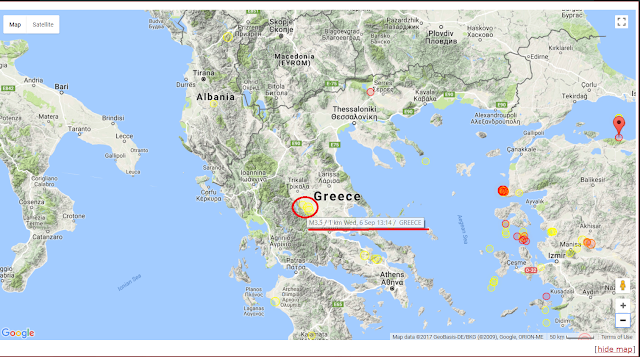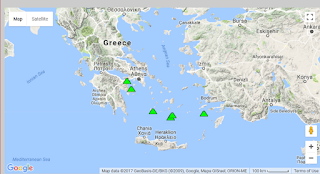Greece's Main Natural Hazards
There are several natural hazards and threats that can affect the beautiful country that is Greece. However, two of the largest threats to the country in terms of mother nature's fury are earthquakes and volcanoes. These two hazards have caused great damage throughout history. Greece is located in the Mediterranean Sea and is one of the most seismically active countries in the world. Greece ia seismically active due to its unique location in between tectonic plates. It sits in between the Eurasian, Aegean, and African plates, which are all constantly moving against one another at speeds of up to 30 millimeters per minute. This constant movement triggers seismic activity up in the northern and central areas of Greece. As a result, several earthquakes are bound to happen, some small, others large and destructive. Down below is an image depicting Greece's location within its surrounding tectonic plates.
The Greek island of Kos experienced a terrible earthquake back in July of 2017. Approximately over 500 people were injured and two others perished. The seismic activity was the result of a an underwater quake that also damaged several parts of Turkey. Below is a picture showing some of the damage that was inflicted in Kos by the earthquake.
The second natural hazard that is very active in Greece are volcanoes. Greece is sitting on one of the most active volcanic underwater activity. It is called the Hellenic Volcanic Arc. This phenomenon parallels the subduction zone at an approximate distance of 120km up north. It contains quite a large amount of active volcanoes such as Methana, Santorini, Nisyros, and also the Bodrum Peninsula. The Santorini volcano is arguably the most infamous of them all. It is the one that wiped off the Minoan population that inhabited the island in 1640 B.C. It's been active ever since although in recent years its been laying dormant. Below is an image of the Santorini volcano erupting in 1950.
In my opinion, the biggest recommendation I'd give to try and mitigate these hazards would be to invest in an improved education system. With more education, citizens would be taught how to follow safety procedures during any of these natural disasters. Furthermore, I would target the people living in the coasts first, as those people are bound to get hit by a volcano or tsunami triggered by an earthquake first. I would propose an infrastructure plan to help improve the coastal walls and cliff nets. If I could choose to live anywhere in the country I would live in the island of Santorini. I'd build my house and enjoy a breathtaking view into the Santorini volcano and the Mediterranean sea. Below is just a slight idea of the views the place offers.
References:
Google Images
https://www.volcanodiscovery.com/hellenic-arc.html http://geographyofgreece.blogspot.com/2014/09/plate-tectonics.html
https://www.tripsavvy.com/earthquakes-in-greece-1526228







Very interesting blog! Very well organized! I enjoyed the images :)
ReplyDelete